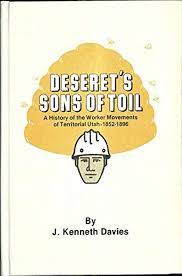Articles/Essays – Volume 11, No. 2
Mormonism and Labor | J. Kenneth Davies, Deseret’s Sons of Toil, A History of the Worker Movements of Territorial Utah, 1852–1896
J. Kenneth Davies, a long-time student of Utah labor history, has been interested in the relationship between the labor movement in Utah and the Mormon Church. Deseret’s Sons of Toil is intended to be a detailed study of that relationship during the half century before Utah became a state. The first book published on Utah labor history, it calls attention to an important and neglected subject, provides a useful sketch of the early Utah labor movement, raises some important issues and brings together a number of valuable facts. As a whole, however, the book is disappointing. It is badly organized, repititious and awkwardly written. The level of analysis and discussion throughout is superficial, and much of the content is trivial.
Davies opens the book with a discussion of current Mormon attitudes toward labor. From his previous studies, he has concluded that Mormons as a body have developed a philosophy of labor with strong anti-union overtones, and that the more active a church member is, the more likely he is to be opposed to unions. On the other hand, most Mormons feel that unions and Christianity are basically compatible, and many Mormons belong to unions. The roots of these attitudes, Davies believes, are to be found in the last half of the nineteenth century.
Having had predecessors in Nauvoo, worker organizations evolved early in Utah. By 1861, fifty crafts were organized and until the late 1860’s had the encouragement and even the sponsorship of the authorities of the Mormon Church, including Brigham Young. They were controlled by active Mormons, and some of them were open only to Mormons. In the late 1860’s and early 1870’s, the situation began to change. Over the next two decades, the membership and leadership of unions became increasingly non-Mormon, the labor movement became more and more independent of the Mormon church, and the church became increasingly hostile to unions. By the time Utah became a state in 1896, the labor movement was as secularized as the state’s economic and political life. A variety of factors were responsible, the most important of which was a heavy influx of non-Mormon workers into Utah after 1869, particularly in the railroad and mining industries; the cooperative movement of the Mormon church, which drew off many Mormons from union activity; the opposition of Mormons to the closed shop as a denial of the principle of free agency; the anti-union philosophy of church leaders, who tended to be employers; and the predisposition of many Mormons to accept the views of church leaders on all questions, social, economic and political, as well as religious.
Davies provides a useful outline of early Utah labor history and in doing so raises some interesting points. The problem, however, is that in the course of the book, the outline is barely filled in, and the issues raised are not pursued. He says, for example, that the Church itself, and church leaders, had the psychology of employers and were thus bound to come into conflict with their Mormon and non-Mormon employees; that there long existed among the Mormons a distrust of gentiles and apostates; that Mormon union-members found it increasingly difficult to reconcile the demands of their church and their union. These ideas, and others, are not discussed or analyzed, however. They are merely noted. Their full implications and the way in which they worked out in practice are consequently not shown.
Davies says too little about important points. At the same time, he says too much about things of little importance. The impression is that the author was determined to tell his readers everything he knew about the early Utah labor movement whether it was significant or not.
The result of saying both too much and too little is that, at the end, fundamental questions have gone unanswered. Why were unions in Utah organized in the first place? What did they stand for and what did they seek to achieve? How were their philosophies implemented? What kind of people joined unions? Were they native-born or foreign-born? Skilled or unskilled? What response, other than increasing hostility from Mormon authorities, did unions meet? What impact did they have? What, if anything, did they accomplish? These questions, central to an understanding of unionism in Utah, are largely unexamined.
Deseret’s Sons of Toil, A History of the Worker Movements of Territorial Utah, 1852-1896 by J. Kenneth Davies. Salt Lake City: Olympus Publishing Co., 1977, 264 pp. $9.95


 Back to full Issue
Back to full Issue

